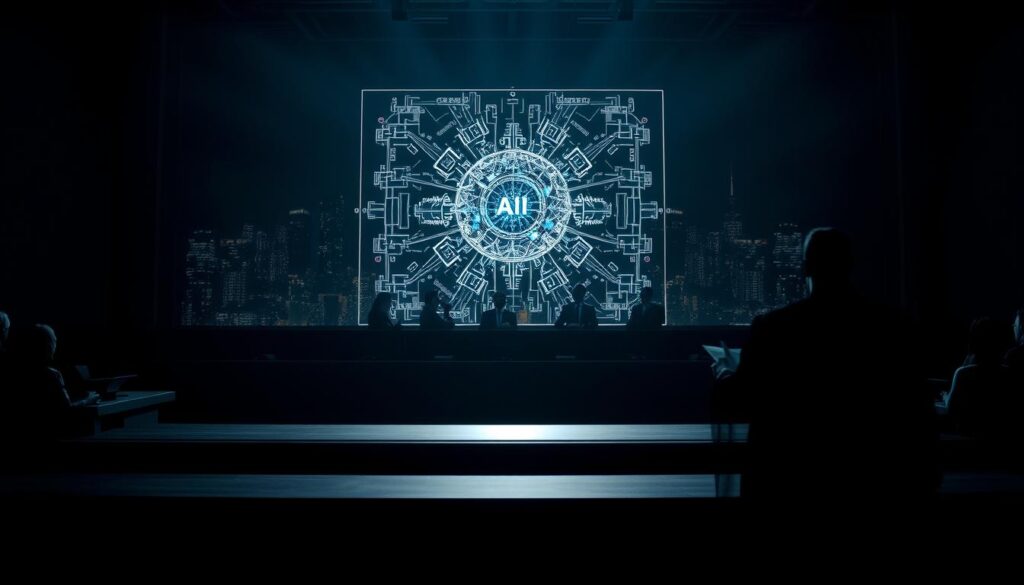Did you know that by 2025, the global artificial intelligence market is projected to exceed $190 billion? As AI technologies penetrate every facet of our lives, the focus on ethical dilemmas in AI intensifies. These rapid advancements raise immediate concerns about modern technology ethics. It is imperative to grasp these challenges to ensure AI governance, protect human rights, and promote fairness and equity. This article explores the widespread ethical hurdles in AI, encompassing privacy, bias, job displacement, and security threats. It aims to lay the foundation for responsible AI development and deployment.
By the end of this exploration, you’ll gain insights into how modern technology ethics and robust AI governance frameworks are essential in mitigating these challenges, ensuring AI’s positive societal impact.
Key Takeaways
- The AI market is growing rapidly, expected to surpass $190 billion by 2025.
- Ethical dilemmas in AI cover a range of issues from privacy to bias.
- Modern technology ethics are not abstract but have immediate, practical implications.
- AI governance is essential in navigating the ethical landscape of AI technologies.
- Responsible AI development considers equity and human rights alongside technical advancements.
- Continuous dialogue with experts is key to addressing AI’s ethical challenges.
Understanding AI Ethics
As artificial intelligence advances, the need to grasp AI ethics grows. Ensuring AI development is responsible is crucial. It means that technological progress must align with human values and societal norms.
The Importance of Ethical Guidelines
Ethical guidelines are essential for AI’s future. They offer a roadmap for developers in the complex AI innovation field. By following AI ethical guidelines, developers can create systems that respect human rights and foster inclusivity. The European Union and IEEE have proposed frameworks for universal ethical AI standards.
These standards aim to address the ethical implications of AI decision-making. They guide responsible AI development and build trust among users.
Defining Ethical AI
Ethical AI is guided by principles of fairness, transparency, and accountability. Clearly defining these principles is vital for addressing ethical AI implications effectively. An ethically sound AI system prioritizes individual and community well-being, avoiding biases and inequalities.
Developers must engage in ongoing dialogue and update ethical standards as AI evolves. Embedding these principles in AI development ensures technologies that benefit society, minimizing harm.
Privacy Concerns in AI
The rapid advancement of artificial intelligence has brought privacy concerns to the forefront. AI systems heavily rely on collecting personal data, often conflicting with individual privacy rights. Understanding how data is collected and ensuring user consent and transparency in AI are paramount.
Data Collection Practices
AI’s need for large datasets necessitates ethical data collection practices. Companies collect vast amounts of personal information, sometimes without transparency or user understanding. This can lead to misuse and raises significant data privacy issues. The Facebook-Cambridge Analytica scandal is a stark example of the consequences of inadequate data collection.
Ensuring ethical data collection involves clear communication and transparent policies. Users must be fully aware of how their data is used. This is crucial for maintaining trust and privacy.
User Consent and Transparency
Granting users control over their personal information is essential. *Transparency in AI* systems are critical. Companies must obtain explicit consent and explain data collection, usage, and sharing. Misuse of user data by corporations highlights the need for transparent data policies.
Establishing robust protocols with transparency at their core can mitigate privacy concerns. This fosters trust in AI technologies.
To ensure these practices, organizations should:
- Adopt clear and concise data privacy policies.
- Implement user-friendly consent mechanisms.
- Regularly audit AI systems to maintain transparency in AI processes.
By addressing privacy concerns and focusing on ethical data collection and user transparency, we can develop responsible AI. This respects user privacy and builds public trust.
Algorithmic Bias and Fairness
Artificial intelligence’s growing role in decision-making has highlighted the critical issue of algorithmic bias. Ensuring AI fairness is paramount to avoid the adverse effects of biased data.
Identifying Bias in AI Systems
Spotting bias in machine learning systems is a daunting task. It necessitates thorough testing and ongoing surveillance to uncover biases that could perpetuate discrimination. These biases frequently originate from datasets that inadequately represent diverse populations. A comprehensive strategy is required, encompassing diverse training data, bias mitigation strategies, and regular audits.
The Impact of Biased Algorithms
Biased algorithms exert significant influence, notably in critical areas like law enforcement, credit scoring, and recruitment. For example, in law enforcement, such biases can unfairly target minority groups. In recruitment, they can hinder equal opportunities for candidates from various backgrounds. Overcoming bias in machine learning transcends a mere technical hurdle; it is a societal necessity to uphold fairness and equity for everyone.
In summary, combating algorithmic bias and championing AI fairness are continuous endeavors demanding unwavering commitment. By tackling these challenges, you play a crucial role in fostering equitable AI systems that treat all individuals with justice.
Accountability in AI Decision-Making

In our era, the topic of accountability in AI has gained significant attention. The issue arises when AI systems make decisions, leading to adverse outcomes. Identifying who bears the responsibility is crucial. This dilemma not only shapes the ethics of AI but also underscores the essential role of responsible developers and organizations.
Who is Responsible?
AI systems, though created by humans, can function autonomously. This autonomy complicates the question of liability. The Uber self-driving car incident, for example, underscored the need for clear accountability in AI decision-making. When AI systems cause harm or behave unexpectedly, it’s challenging to determine whether the fault lies with the developers, the system itself, or the organization using it.
The Role of Developers and Organizations
Given the intricacies of AI systems, it is essential for responsible developers to embed ethical considerations into their work. Organizations must also establish robust oversight mechanisms to ensure these systems operate ethically. Effective accountability in AI necessitates a partnership between developers and organizations. This collaboration is key to proactively addressing potential issues and reducing risks associated with AI decision-making.
Job Displacement and Economic Impact
Artificial intelligence is revolutionizing industries, leading to profound changes in workforce dynamics. The *AI workforce impact* is both promising and challenging, reshaping job roles and necessitating new skill sets.
The Future of Work with AI
The integration of AI into various sectors signals a profound shift in the future of work. While some roles face *job displacement*, AI also creates opportunities for new positions that didn’t exist before. Businesses must navigate these changes by fostering a culture of continual learning and adaptation.
Industries like manufacturing and healthcare are already seeing AI-driven efficiency. For instance, automation in manufacturing can streamline processes but may lead to a reduction in certain manual jobs. On the other hand, healthcare applications of AI can enhance diagnostics and patient care, creating jobs in AI consultancy and data management.
Addressing the Skills Gap
One of the most pressing challenges posed by AI is the *skills gap in AI economy*. As technology evolves, the demand for specialized skills grows, often outpacing the available workforce. Addressing this requires a multifaceted approach.
- Implement reskilling programs that equip workers with necessary AI and tech-related skills.
- Collaborate with educational institutions to incorporate AI-centric curricula.
- Foster industry partnerships to provide real-world training opportunities.
Through these efforts, organizations can bridge the gap, ensuring that the workforce remains competitive and capable of thriving in an AI-driven economy.
Security Risks Associated with AI

As artificial intelligence (AI) advances at a rapid pace, the urgency to address AI safety grows. It transcends mere buzzword status, becoming a fundamental imperative in our digital era. The integration of AI across various domains introduces novel cybersecurity challenges. These necessitate the deployment of advanced, resilient countermeasures.
Cybersecurity Threats
The emergence of cybersecurity threats targeting AI systems poses a significant concern. These threats encompass data poisoning, adversarial attacks, and model inversion. Such vulnerabilities underscore the critical need for holistic cybersecurity strategies in AI. Cybercriminals exploit these weaknesses to orchestrate AI-facilitated cyberattacks, posing threats to critical infrastructure and severe repercussions.
Building Resilient AI Systems
The imperative for resilient AI technology is unequivocal. The development of systems capable of withstanding and rapidly recovering from security breaches is paramount. This entails the adoption of stringent encryption, continuous surveillance, and periodic updates to mitigate vulnerabilities. Further, embedding AI safety protocols during development can substantially diminish risks. Adopting a proactive security posture not only safeguards assets but also fortifies the trustworthiness and dependability of AI technologies.
Misinformation and Deepfakes
The advent of AI-generated content has ignited fervent debates regarding its capacity to disseminate misinformation and deepfakes. These technologies, driven by artificial intelligence, are adept at producing content that mimics reality with uncanny precision. This capability raises critical concerns for the integrity of media, the political sphere, and individual security.
The Rise of AI-Generated Content
Advances in artificial intelligence have democratized the creation of realistic audio, video, and text. This development is notably concerning in the realm of deepfakes, where AI manipulates footage for nefarious ends. The widespread dissemination of such content threatens the veracity of information, exacerbating during pivotal moments such as elections. For a deeper exploration of the ethical and regulatory hurdles in this domain, refer to this comprehensive article.
Strategies to Combat Misinformation
Efforts to counteract misinformation necessitate a comprehensive strategy. Several tactics stand out as effective:
- Enhanced Detection Technologies: Utilizing AI to detect and alert users to potentially deceitful or tampered content can significantly limit the dissemination of AI-generated content.
- Regulatory Policies: Implementing and enforcing laws that penalize creators and disseminators of false information is imperative.
- Public Awareness Campaigns: Educating the populace about the perils of deepfakes is vital for cultivating a more discerning audience.
By embracing these strategies, individuals can actively contribute to the fight against misinformation and the detrimental impacts of AI-generated content in our digital environment.
Autonomy and Control in AI Systems
The rapid advancement of autonomous AI has ignited intense debates on ethical considerations. As we grant more autonomy to these systems, understanding the balance between their decision-making capabilities and our control over AI systems becomes crucial.
The Dilemma of Autonomous Decision Making
Autonomous decision making in AI systems presents a double-edged sword. These systems can operate independently, enhancing efficiency and productivity. Yet, without proper human oversight in AI, they can make decisions that diverge from human ethics and values. The use of autonomous vehicles is a prime example, where they must make rapid decisions that could impact human lives.
Human Oversight and Responsibility
Maintaining human oversight in AI ensures these technologies remain in sync with societal norms and ethical standards. Effective oversight mechanisms involve integrating control over AI systems from their development stages to their deployment and operation. High-profile cases, where lack of human intervention led to significant ethical mishaps, underscore the oversight’s importance. For instance, in healthcare, AI diagnosis tools must always be supervised by qualified medical professionals to ensure patient safety and uphold ethical medical practices.
AI in Surveillance and Monitoring
In the modern surveillance landscape, AI technology serves as a dual-edged sword. It offers enhanced security, yet it also raises critical questions about AI and human rights. As AI surveillance systems expand worldwide, it is imperative to explore the ethical implications of these technologies.
Ethics of Surveillance Technology
Surveillance technology ethics demand a nuanced understanding of technological progress versus moral obligations. It is essential to analyze how these systems function, focusing on their effects on privacy vs security. For example, in China, AI surveillance has enabled state authorities to monitor citizens on a massive scale. This has sparked concerns about individual freedoms and human rights. It prompts discussions on whether the benefits justify the ethical costs.
Balancing Security and Privacy
The challenge of balancing robust security with privacy rights is significant. Governments claim AI surveillance is crucial for national security, but critics argue it often violates personal freedoms. In the United States, the tension between law enforcement needs and citizens’ privacy rights is evident. Establishing frameworks for surveillance technology ethics is necessary to prevent these systems from eroding societal trust and human rights.
Ethical Frameworks for AI Development
The realm of AI necessitates a solid ethical framework to align technological progress with societal norms. The establishment of AI ethical frameworks is crucial for guiding developers and organizations in the deployment of artificial intelligence responsibly.
Existing Models and Guidelines
Globally, numerous models and guidelines have been formulated to address ethical dilemmas in AI. For example, entities like the European Commission and professional bodies such as IEEE have introduced detailed guidelines. These focus on transparency, accountability, and fairness. By adhering to these frameworks, organizations can standardize AI ethics, fostering more trustworthy AI systems.
Documents like the OECD’s AI Principles also provide insights into responsible AI practices. These guidelines underscore the significance of human-centric AI. They ensure AI technologies are developed and utilized to benefit society, while respecting human rights.
The Role of International Standards
The increasing importance of international standards in AI development highlights the need for universally accepted guidelines. Various international initiatives, including those by the G20, aim to harmonize AI ethical principles across borders. By standardizing AI ethics, these efforts aim to promote a unified approach to ethical AI deployment.
International AI guidelines are essential for ensuring interoperable and ethically sound AI systems. Organizations globally can leverage these standards to create AI systems that are both effective and responsible. This promotes global cooperation in the ethical development of AI.
The Future of AI Ethics
The future of AI ethics is a rapidly evolving domain, necessitating constant vigilance from all involved parties. As AI systems permeate every aspect of our lives, the imperative to address their ethical implications intensifies. The emergence of new AI trends is reshaping our digital environment, compelling stakeholders to reevaluate existing ethical frameworks and contemplate novel considerations.
Emerging Trends and Considerations
Artificial intelligence’s integration into sectors like healthcare and space exploration stands out as a significant trend. These developments introduce a plethora of ethical dilemmas that demand meticulous scrutiny. For example, AI’s role in medical diagnostics and treatments mandates the establishment of rigorous ethical standards to safeguard patient well-being and data security. Simultaneously, the application of AI in space missions raises ethical concerns regarding autonomous decision-making in the unknown.
The Importance of Ongoing Dialogue
An ethical AI dialogue among policymakers, technologists, and the general public is crucial. This continuous exchange must be both dynamic and inclusive, promoting a collaborative effort to tackle emerging and unforeseen challenges. Such dialogue ensures diverse viewpoints are integrated, resulting in more comprehensive and effective ethical frameworks. As AI ethics continues to evolve, sustaining this dialogue will be vital for adapting to technological advancements and embedding ethical considerations into AI development and application.

